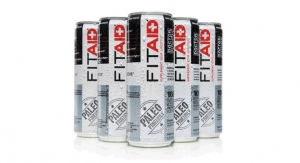Joanna Cosgrove, Online Editor01.17.13
Rheumatoid arthritis (RA) is a debilitating inflammatory joint disease that affects about 1.3 million adults in the U.S. Though the exact causes of RA are still unknown, the disease triggers an abnormal immune reaction that destroys cartilage and joint linings, and erodes bone. In severe cases, it can also lead to rheumatoid nodules, vasculitis, heart disease, lung disease, anemia and peripheral neuropathy. But a new pilot study published in the Journal of Modern Research in Inflammation by researchers at the Riordan Clinic in Wichita, KA, found that high dose vitamin C delivered intravenously can have a beneficial effect on RA-associated inflammation and pain.
Dr. Nina Mikirova, senior research scientist at the Riordan Clinic, explained that oxidative stress is elevated in RA patients, which implies that reactive oxygen species (ROS) are present as possible mediators of tissue damage. ROS trigger a cascade of events through nuclear factors' activation, which up-regulates gene expression of pro-inflammatory cytokines that mediate the immune responses causing inflammation. In short, reducing inflammation and oxidative stress can protect cartilage as it regenerates within the joint. Control of inflammation is also important when it comes to the reduction of cardiovascular risk.
The Riordan Clinic has studied the use of highly concentrated ascorbic acid to treat illnesses associated with inflammation, including cancer, atherosclerosis and viral infections for decades. According to the researchers, at high doses, vitamin C has been shown to reduce the production of pro-inflammatory cytokines. “Ascorbic acid has other properties that suggest it may be useful in treating rheumatoid arthritis: it is an antioxidant that scavenges ROS and it supports collagen formation and enhances extracellular matrix protein synthesis,” they wrote.
What’s more, researchers found RA patients tended to be vitamin C deficient and required supplementation in high doses in order to maintain acceptable plasma vitamin C levels. In addition to low vitamin C levels in the blood, the researchers said studies have shown below-normal ascorbic acid concentrations have also been observed in the synovial fluid of RA patients.
Dr. Mikirova told Nutraceuticals World she wasn’t entirely surprised at the results her team’s new research into RA yielded. “When administered at much higher–than-recommended dietary allowance levels, vitamin C has been suggested of having both a preventative and therapeutic role in a number of pathologies, including cancer, atherosclerosis and viral infections, so we expected that high dosages of vitamin C can be beneficial in treatment of RA,” she said. “Hallmarks of RA pathology are chronic inflammation and pronounced synovial hyperplasia. In addition, oxidative stress is elevated in RA patients implying reactive oxygen species are possible mediators of tissue damage. The balance between pro- and anti-inflammatory cytokines due to chronic inflammation is a substantial feature of this disease.”
She went on to explain how her previous work has dovetailed with her current work on RA. “It is well known that vitamin C is essential for the building of collagen, the most abundant protein built in our bodies and the major component of connective tissue, and as antioxidant,” she said. “In our previous study of the effect of intravenous high dose vitamin C on the level of inflammation and pro-inflammatory cytokines, we demonstrated that vitamin C suppresses the release of inflammatory cytokines and decrease the inflammation in cancer patients (Journal of Translational Medicine, 2012, 10:189). So, we expected that the same treatment would have an effect on inflammation in patients with RA.”
The RA patients in the Riordan Clinic study were characterized by moderate to high levels of the inflammation marker CRP, which indicated moderate to severe discomfort levels. “The effect of intravenous vitamin C (IVC) treatment on subjects with RA demonstrated that IVC therapy with dosages of 7.5 g-50g can reduce inflammation and the pain levels,” the researchers wrote. “The inflammation as measured by C-reactive protein levels was decreased on average by 44%. The average CRP level before treatment was 9.4 +/- 4.6 mg/L, while the average after IVC therapy was 6.4 +/- 4.6 mg/L. Examining those subjects who showed a net CRP decrease, we found that the effect of treatment is IVC frequency dependent.”
When asked if there were specific properties that made vitamin C a more preferable treatment option to other antioxidants, Dr. Mikirova acknowledged the use of other alternative medicine therapy treatments and nutritional adjustment practices. “Some, such as gamma-linolenic acid, fish oil, antioxidants and other supplementations have shown some possibility of benefit for RA, but a very limited number of controlled intervention trials have been conducted to evaluate dietary supplementation with antioxidants in RA development,” she said. “Several studies with vitamin E supplementation, selenium-enriched yeast supplementation, fatty acids, micronutrients and antioxidant supplementations demonstrated improvements but not significant clinical benefits. In the study with antioxidant supplementation, the level of vitamin C was only three to five times higher than recommended daily allowance.”
“We suggest the treatment should be by intravenous high dose vitamin C, as the in vitro experiments demonstrate that only high dose vitamin C can suppress activation of nuclear factor (NF-kB), which mediates the production of many pro-inflammatory cytokines,” she continued. “The effect requires millimolar concentrations of vitamin C [attainable via intravenous infusions].”
While the Riordan Clinic’s RA pilot study yielded promising results, the researchers acknowledged more research is warranted. “Our pilot study was based on the results of treatment on patients with RA at Riordan Clinic [who] had different intervals between IVC treatments and different numbers of treatments,” said Dr. Mikirova. “We think the results should be supported by the study on a larger population of RA patients with a standardized protocol of treatment and more detailed analyses of inflammation markers and patients’ conditions.”
Dr. Nina Mikirova, senior research scientist at the Riordan Clinic, explained that oxidative stress is elevated in RA patients, which implies that reactive oxygen species (ROS) are present as possible mediators of tissue damage. ROS trigger a cascade of events through nuclear factors' activation, which up-regulates gene expression of pro-inflammatory cytokines that mediate the immune responses causing inflammation. In short, reducing inflammation and oxidative stress can protect cartilage as it regenerates within the joint. Control of inflammation is also important when it comes to the reduction of cardiovascular risk.
The Riordan Clinic has studied the use of highly concentrated ascorbic acid to treat illnesses associated with inflammation, including cancer, atherosclerosis and viral infections for decades. According to the researchers, at high doses, vitamin C has been shown to reduce the production of pro-inflammatory cytokines. “Ascorbic acid has other properties that suggest it may be useful in treating rheumatoid arthritis: it is an antioxidant that scavenges ROS and it supports collagen formation and enhances extracellular matrix protein synthesis,” they wrote.
What’s more, researchers found RA patients tended to be vitamin C deficient and required supplementation in high doses in order to maintain acceptable plasma vitamin C levels. In addition to low vitamin C levels in the blood, the researchers said studies have shown below-normal ascorbic acid concentrations have also been observed in the synovial fluid of RA patients.
Dr. Mikirova told Nutraceuticals World she wasn’t entirely surprised at the results her team’s new research into RA yielded. “When administered at much higher–than-recommended dietary allowance levels, vitamin C has been suggested of having both a preventative and therapeutic role in a number of pathologies, including cancer, atherosclerosis and viral infections, so we expected that high dosages of vitamin C can be beneficial in treatment of RA,” she said. “Hallmarks of RA pathology are chronic inflammation and pronounced synovial hyperplasia. In addition, oxidative stress is elevated in RA patients implying reactive oxygen species are possible mediators of tissue damage. The balance between pro- and anti-inflammatory cytokines due to chronic inflammation is a substantial feature of this disease.”
She went on to explain how her previous work has dovetailed with her current work on RA. “It is well known that vitamin C is essential for the building of collagen, the most abundant protein built in our bodies and the major component of connective tissue, and as antioxidant,” she said. “In our previous study of the effect of intravenous high dose vitamin C on the level of inflammation and pro-inflammatory cytokines, we demonstrated that vitamin C suppresses the release of inflammatory cytokines and decrease the inflammation in cancer patients (Journal of Translational Medicine, 2012, 10:189). So, we expected that the same treatment would have an effect on inflammation in patients with RA.”
The RA patients in the Riordan Clinic study were characterized by moderate to high levels of the inflammation marker CRP, which indicated moderate to severe discomfort levels. “The effect of intravenous vitamin C (IVC) treatment on subjects with RA demonstrated that IVC therapy with dosages of 7.5 g-50g can reduce inflammation and the pain levels,” the researchers wrote. “The inflammation as measured by C-reactive protein levels was decreased on average by 44%. The average CRP level before treatment was 9.4 +/- 4.6 mg/L, while the average after IVC therapy was 6.4 +/- 4.6 mg/L. Examining those subjects who showed a net CRP decrease, we found that the effect of treatment is IVC frequency dependent.”
When asked if there were specific properties that made vitamin C a more preferable treatment option to other antioxidants, Dr. Mikirova acknowledged the use of other alternative medicine therapy treatments and nutritional adjustment practices. “Some, such as gamma-linolenic acid, fish oil, antioxidants and other supplementations have shown some possibility of benefit for RA, but a very limited number of controlled intervention trials have been conducted to evaluate dietary supplementation with antioxidants in RA development,” she said. “Several studies with vitamin E supplementation, selenium-enriched yeast supplementation, fatty acids, micronutrients and antioxidant supplementations demonstrated improvements but not significant clinical benefits. In the study with antioxidant supplementation, the level of vitamin C was only three to five times higher than recommended daily allowance.”
“We suggest the treatment should be by intravenous high dose vitamin C, as the in vitro experiments demonstrate that only high dose vitamin C can suppress activation of nuclear factor (NF-kB), which mediates the production of many pro-inflammatory cytokines,” she continued. “The effect requires millimolar concentrations of vitamin C [attainable via intravenous infusions].”
While the Riordan Clinic’s RA pilot study yielded promising results, the researchers acknowledged more research is warranted. “Our pilot study was based on the results of treatment on patients with RA at Riordan Clinic [who] had different intervals between IVC treatments and different numbers of treatments,” said Dr. Mikirova. “We think the results should be supported by the study on a larger population of RA patients with a standardized protocol of treatment and more detailed analyses of inflammation markers and patients’ conditions.”



















